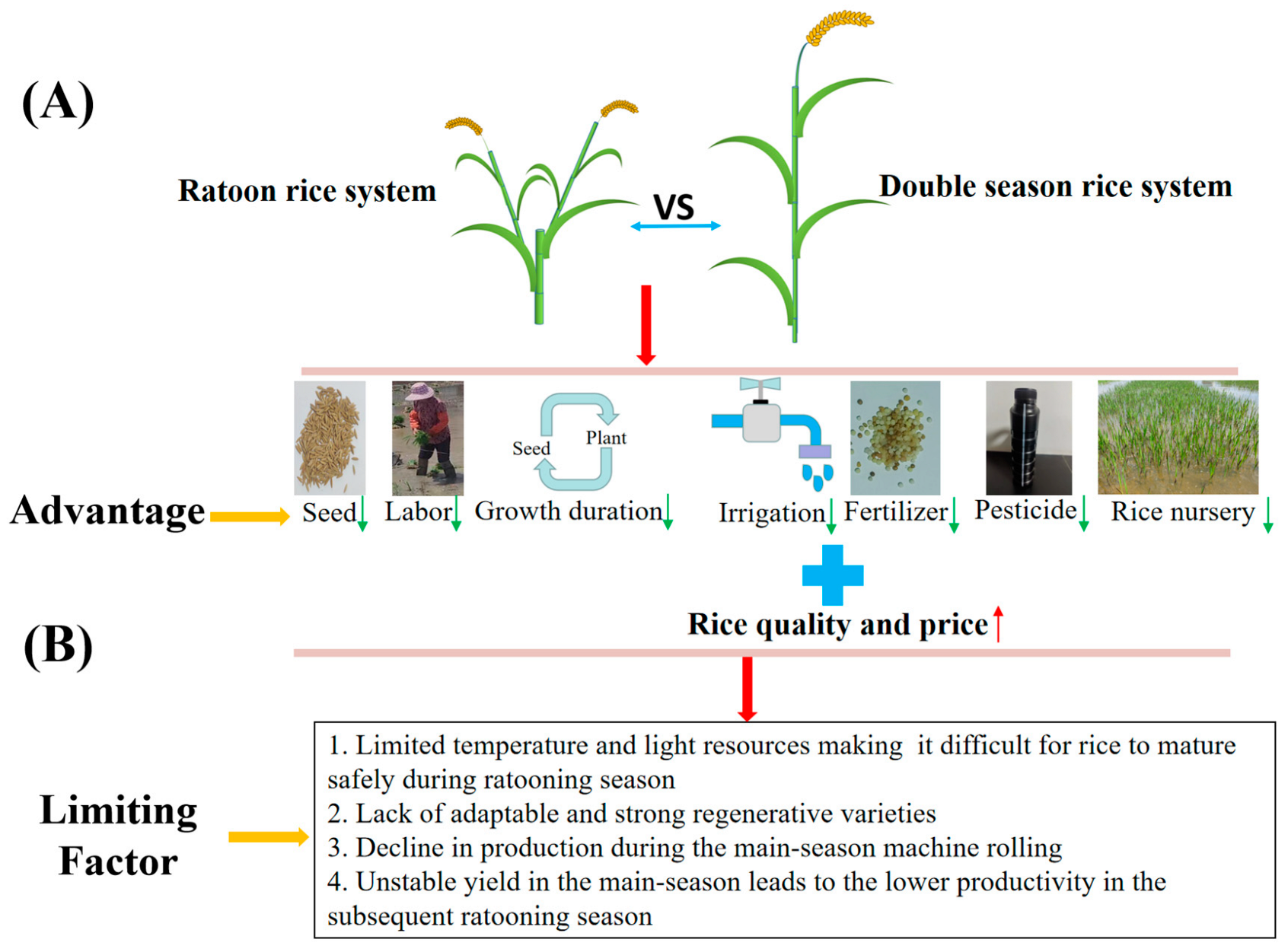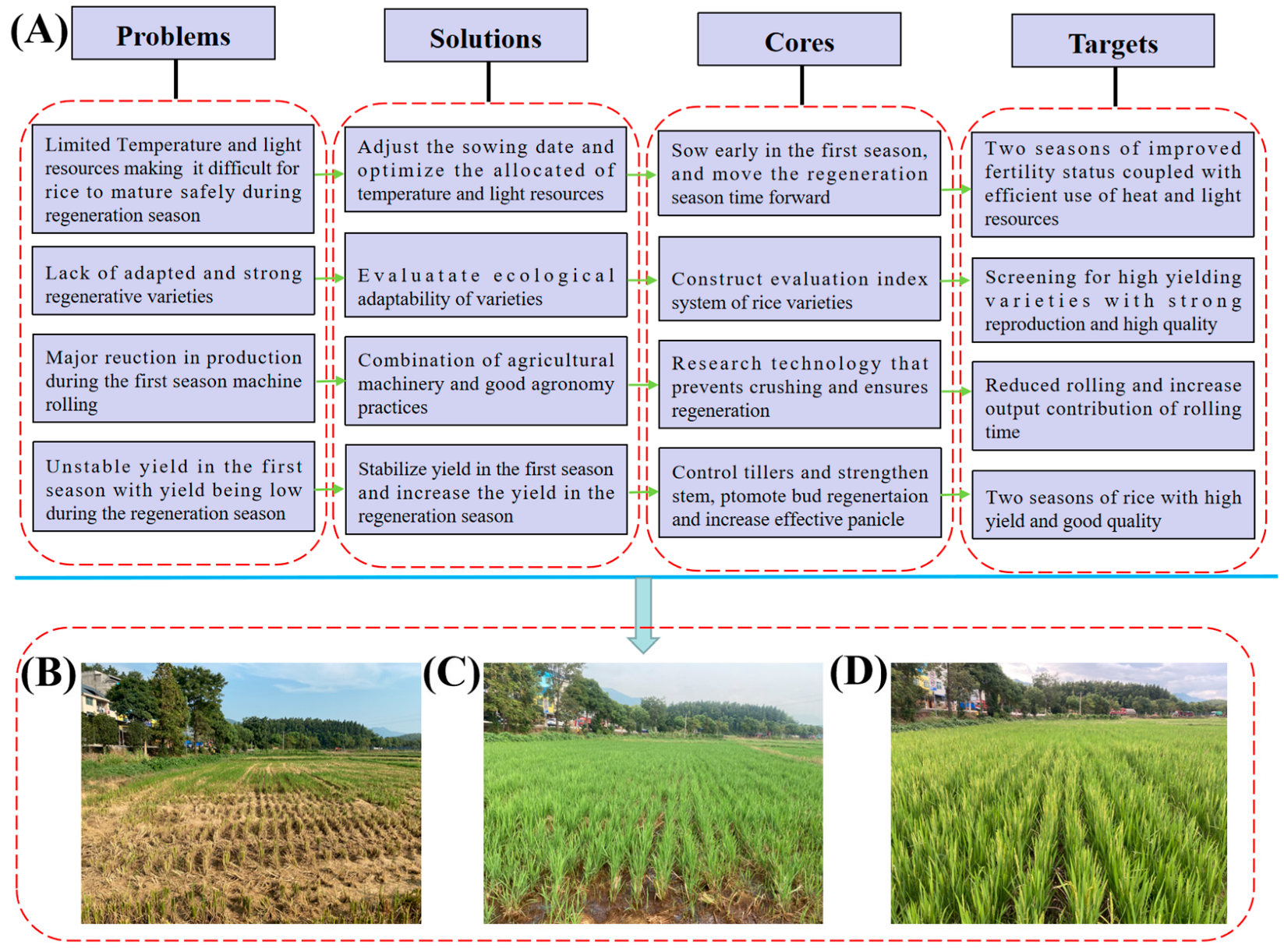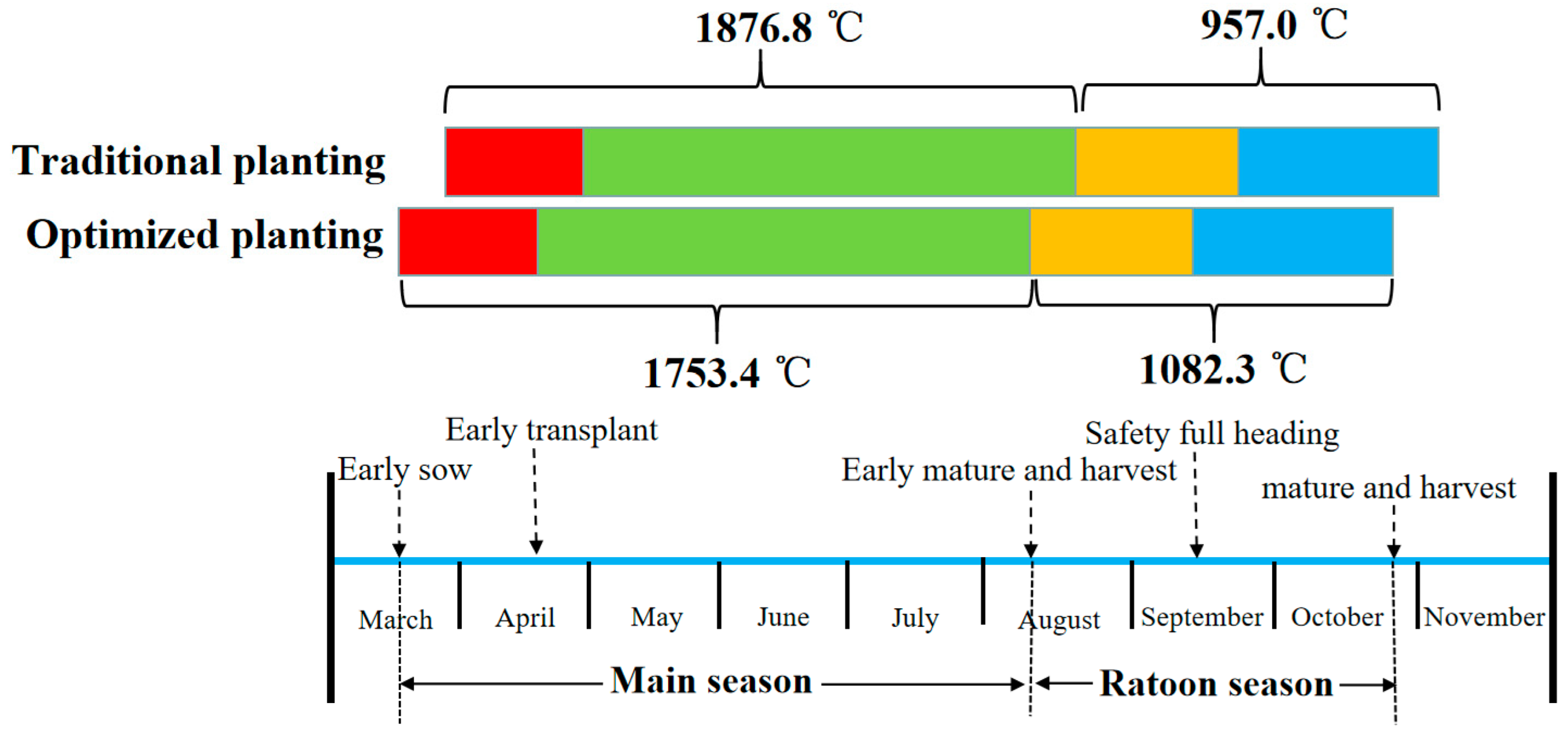Ratoon Rice System of Production: A Rapid Growth Pattern of Multiple Cropping in China: A Review
Abstract
:1. Introduction
2. Mechanical Harvesting of the Main Season Is the Key to the Development of Ratoon Rice
3. Factors Limiting the Yield of Machine-Harvested Ratoon Rice
3.1. Strong Regenerative Varieties Are Lacking
3.2. Limited Temperature and Light Resources Makes It Difficult for Ratoon Rice to Mature Safely in the Ratooning Season
3.3. The Main Season of Mechanical Rolling Caused a Serious Reduction in Production
3.4. The Yield Was Unstable in the Main Season and Low in the Ratooning Season
4. Three Central Cores in the Research of Ratoon Rice
4.1. Compared with Main Season Rice and Late Heading Rice, Material Transport Was Higher in the Ratooning Season
4.2. Compared with Main Season Rice and Late Heading Rice, the Rice Quality in the Ratoon Season Was Better
4.3. Compared with Main Season Rice and Late Heading Rice, Ratoon Rice Had Lower Greenhouse Gas Emission
5. Conclusions and Prospects
Author Contributions
Funding
Data Availability Statement
Conflicts of Interest
References
- Seck, P.A.; Diagne, A.; Mohanty, S. Crops That Feed the World 7: Rice; Springer: Berlin/Heidelberg, Germany, 2012. [Google Scholar]
- Ray, D.K.; A Foley, J. Increasing global crop harvest frequency: Recent trends and future directions. Environ. Res. Lett. 2013, 8, 044041. [Google Scholar] [CrossRef]
- Deng, N.; Grassini, P.; Yang, H.; Huang, J.; Cassman, K.G.; Peng, S. Closing yield gaps for rice self-sufficiency in China. Nat. Commun. 2019, 10, 1725. [Google Scholar] [CrossRef] [PubMed]
- Peng, S.; Huang, J.; Sheehy, J.E.; Laza, R.C.; Visperas, R.M.; Zhong, X.; Centeno, G.S.; Khush, G.S.; Cassman, K.G. Rice yields decline with higher night temperature from global warming. Proc. Natl. Acad. Sci. USA 2004, 101, 9971–9975. [Google Scholar] [CrossRef] [PubMed]
- Fei, W.; Huang, J.; Shaobing, P. Research and development of mechanized rice ratooning technology in China. China Rice 2021, 27, 1. [Google Scholar]
- Mengel, D.B.; Wilson, F.E. Water Management and Nitrogen Fertilization of Ratoon Crop Rice 1. Agron. J. 1981, 73, 1008–1010. [Google Scholar] [CrossRef]
- Huang, J.; Pan, Y.; Chen, H.; Zhang, Z.; Fang, C.; Shao, C.; Amjad, H.; Lin, W.; Lin, W. Physiochemical mechanisms involved in the improvement of grain-filling, rice quality mediated by related enzyme activities in the ratoon cultivation system. Field Crop. Res. 2020, 258, 107962. [Google Scholar] [CrossRef]
- Yuan, S.; Cassman, K.G.; Huang, J.; Peng, S.; Grassini, P. Can ratoon cropping improve resource use efficiencies and profitability of rice in central China? Field Crops Res. 2019, 234, 66–72. [Google Scholar] [CrossRef]
- Lin, W.-X. Developmental status and problems of rice ratooning. J. Integr. Agric. 2019, 18, 246–247. [Google Scholar] [CrossRef]
- Krishanamurthy, K. Rice ratooning as an alternative to double cropping in tropical Asia. In Rice Ratooning; IRRI: Bangalore India, 1989. [Google Scholar]
- Xu, X.B.; Zhang, J.-G.; Jiang, X.-X. Ratooning in China. In Rice Ratooning; International Rice Research Institute: Los Baños, Philippines, 1988; pp. 79–85. [Google Scholar]
- Xu, L.; Zhan, X.; Yu, T.; Nie, L.; Huang, J.; Cui, K.; Wang, F.; Li, Y.; Peng, S. Yield performance of direct-seeded, double-season rice using varieties with short growth durations in central China. Field Crop. Res. 2018, 227, 49–55. [Google Scholar] [CrossRef]
- Guilong, X.; Jianping, O.; Kailou, L.; Yazhen, L.; Lijun, Z.; Paolan, Y.; Huiwen, H. Effects of Bud Fertilizer and Stubble Types on Grain Yield and Regeneration Capacity of Ratoon Rice in Northeast of Jiangxi Province. Chinese Rice 2016, 22, 27–30. [Google Scholar]
- Zhang, Q.; Liu, X.; Yu, G.; Wang, H.; Feng, D.; Zhao, H.; Liu, L. Agronomic and physiological characteristics of high-yielding ratoon rice varieties. Agron. J. 2021, 113, 5063–5075. [Google Scholar] [CrossRef]
- Liu, X.; Feng, D.; Yu, G.; Zhao, H.; Qiao, L.; Li, Y.; Fan, X.; Liu, M.; Zhang, Q. Effect of Different Sowing Dates in South Henan ‘s Rice-growing Areas on the Growth and Yield of Ratoon Rice. Agric. Res. Asia 2016, 8, 43–47. [Google Scholar]
- Yang, D.; Peng, S.; Zheng, C.; Xiong, Z.; Yang, G.; Deng, S.; Wang, F. Stubble height affects the grain yield of ratoon rice under rainfed conditions. Agric. Water Manag. 2022, 272, 107815. [Google Scholar] [CrossRef]
- Torres, R.O.; Natividad, M.A.; Quintana, M.R.; Henry, A. Ratooning as a management strategy for lodged or drought-damaged rice crops. Crop. Sci. 2020, 60, 367–380. [Google Scholar] [CrossRef] [PubMed]
- Wang, Y.-C.; Li, X.-F.; Lee, T.; Peng, S.-B.; Dou, F.-G. Effects of nitrogen management on the ratoon crop yield and head rice yield in South USA. J. Integr. Agric. 2021, 20, 1457–1464. [Google Scholar] [CrossRef]
- Chen, Q.; He, A.; Wang, W.; Peng, S.; Huang, J.; Cui, K.; Nie, L. Comparisons of regeneration rate and yields performance between inbred and hybrid rice cultivars in a direct seeding rice-ratoon rice system in central China. Field Crop. Res. 2018, 223, 164–170. [Google Scholar] [CrossRef]
- Huang, X.; Yang, S.; Gong, J.; Zhao, Y.; Feng, Q.; Gong, H.; Li, W.; Zhan, Q.; Cheng, B.; Xia, J.; et al. Genomic analysis of hybrid rice varieties reveals numerous superior alleles that contribute to heterosis. Nat. Commun. 2015, 6, 6258. [Google Scholar] [CrossRef]
- E, Z.; Cheng, B.; Sun, H.; Wang, Y.; Zhu, L.; Lin, H.; Wang, L.; Tong, H.; Chen, H. Analysis on Chinese improved rice varieties in recent four decades. Chin. J. Rice Sci. 2019, 33, 9. [Google Scholar]
- Guilian, Z.; Naimei, T.; Shuntang, Z. A Comparative of Ratooning Characteristics of Different Hybrid Rice Combinations. J. Hunan Agric. Univ. 2002, 28, 364–368. [Google Scholar]
- Xu, F.; Zhang, L.; Zhou, X.; Guo, X.; Zhu, Y.; Liu, M.; Xiong, H.; Jiang, P. The ratoon rice system with high yield and high efficiency in China: Progress, trend of theory and technology. Field Crop. Res. 2021, 272, 108282. [Google Scholar] [CrossRef]
- Dou, F.; Tarpley, L.; Chen, K.; Wright, A.L.; Mohammed, A.R. Planting Date and Variety Effects on Rice Main and Ratoon Crop Production in South Texas. Commun. Soil Sci. Plant Anal. 2016, 47, 2414–2420. [Google Scholar] [CrossRef]
- Vergara, B.; Lopez, F.; Chauhan, J. Morphology and Physiology of Ratoon Rice. In Rice Ratooning; International Rice research Institute: Los Baños, Filipinas, 1988; pp. 31–40. [Google Scholar]
- Li, Z.; Feng, S.; Zhan, W.; Xu, L.; Fang, C.; Zhang, Z.; Lin, W. Lsi1 plays an active role in enhancing the chilling tolerance of rice roots. Plant Growth Regul. 2020, 90, 529–543. [Google Scholar] [CrossRef]
- Niu, G.; Wang, G.; Li, B.; Song, C.; Xiao, W.; Zhou, H. Design of Rice Factory Three-dimensional Carpet Raising Seedlings System Engineering. IERI Procedia 2014, 8, 93–100. [Google Scholar] [CrossRef]
- Nakano, H.; Morita, S. Effects of time of first harvest, total amount of nitrogen, and nitrogen application method on total dry matter yield in twice harvesting of rice. Field Crop. Res. 2008, 105, 40–47. [Google Scholar] [CrossRef]
- Santos, A.; Fageria, N.; Prabhu, A. Rice Ratooning Management Practices for Higher Yields. Commun. Soil Sci. Plant Anal. 2003, 34, 881–918. [Google Scholar] [CrossRef]
- Wang, W.; He, A.; Jiang, G.; Sun, H.; Jiang, M.; Man, J.; Ling, X.; Cui, K.; Huang, J.; Peng, S.; et al. Ratoon rice technology: A green and resource-efficient way for rice production. Adv. Agron. 2019, 159, 135–167. [Google Scholar] [CrossRef]
- Fu, J.; Ji, C.; Liu, H.; Wang, W.; Zhang, G.; Gao, Y.; Zhou, Y.; Abdeen, M.A. Research Progress and Prospect of Mechanized Harvesting Technology in the First Season of Ratoon Rice. Agriculture 2022, 12, 620. [Google Scholar] [CrossRef]
- Lin, X.; Lei, Z.; Wu, X.; Huang, S.; Shao, C.; Yang, S.; Li, M.; Liu, J.; Gan, J.; Wen, N. The damage reduction effect of narrowing harvester track and wide-narrow row planting in the mechanized harvesting of ratoon rice. Chin. Agric. Sci. Bull. 2022, 38, 150–155, (Chinese Journal in English). [Google Scholar]
- Chen, X.; Li, H.; Liu, M.; Yu, J.; Zhang, X.; Liu, Z.; Peng, Y. Stubble Righting Increases the Grain Yield of Ratooning Rice After the Mechanical Harvest of Primary Rice. J. Plant Growth Regul. 2021, 41, 1747–1757. [Google Scholar] [CrossRef]
- Lin, W.; Chen, H.; Zhang, Z.; Xu, Q.; Tu, N.; Fang, C.; Ren, W. Research and prospect on physio-ecological properties of ratoon rice yield formation and its key cultivation technology. Chin. J. Eco-Agric. 2015, 4, 392–401, (Chinese Journal in English). [Google Scholar]
- Negalur, R.; Yadahalli, G.; Chittapur, B.; Guruprasad, G.; Narappa, G. Ratoon Rice: A Climate and Resource Smart Technology. Int. J. Curr. Microbiol. Appl. Sci. 2017, 6, 1638–1653. [Google Scholar] [CrossRef]
- Wang, H.; Xu, J.; Liu, X.; Zhang, D.; Li, L.; Li, W.; Sheng, L. Effects of long-term application of organic fertilizer on improving organic matter content and retarding acidity in red soil from China. Soil Tillage Res. 2019, 195, 104382. [Google Scholar] [CrossRef]
- Xi, M.; Xu, Y.; Li, Z.; Hu, R.; Cheng, T.; Zhou, Y.; Tu, D.; Ji, Y.; Xu, X.; Sun, X.; et al. Progress and challenges of rice ratooning technology in Anhui Province, China. Crop. Environ. 2023, 2, 81–86. [Google Scholar] [CrossRef]
- Dong, H.; Chen, Q.; Wang, W.; Peng, S.; Huang, J.; Cui, K.; Nie, L. The growth and yield of a wet-seeded rice-ratoon rice system in central China. Field Crop. Res. 2017, 208, 55–59. [Google Scholar] [CrossRef]
- Yang, D.; Peng, S.; Zheng, C.; Xiang, H.; Huang, J.; Cui, K.; Wang, F. Effects of nitrogen fertilization for bud initiation and tiller growth on yield and quality of rice ratoon crop in central China. Field Crop. Res. 2021, 272, 108286. [Google Scholar] [CrossRef]
- Li, Z.; Li, Z.; Muhammad, W.; Lin, M.; Azeem, S.; Zhao, H.; Lin, S.; Chen, T.; Fang, C.; Letuma, P.; et al. Proteomic analysis of positive influence of alternate wetting and moderate soil drying on the process of rice grain filling. Plant Growth Regul. 2018, 84, 533–548. [Google Scholar] [CrossRef]
- Xie, H. Study on high-yielding cultivation characteristics of super hybrid rice grown as ratoon rice. Hybrid Rice 2010, 25, 17–26, (Chinese Journal in English). [Google Scholar]
- He, A.; Wang, W.; Jiang, G.; Sun, H.; Jiang, M.; Man, J.; Cui, K.; Huang, J.; Peng, S.; Nie, L. Source-sink regulation and its effects on the regeneration ability of ratoon rice. Field Crop. Res. 2019, 236, 155–164. [Google Scholar] [CrossRef]
- Lin, F.; Rensing, C.; Pang, Z.; Zou, J.; Lin, S.; Letuma, P.; Zhang, Z.; Lin, W. Metabolomic analysis reveals differential metabolites and pathways involved in grain chalkiness improvement under rice ratooning. Field Crop. Res. 2022, 283, 108521. [Google Scholar] [CrossRef]
- Yazdpour, H.; Shahri, M.M.; Soleymani, A.; Shahrajabian, M.H. Effects of harvesting time and harvesting height on grain yield and agronomical characters in rice ratoon (Oryza sativa L.). J. Food Agric. Environ. 2012, 10, 438–440. [Google Scholar]
- Deng, F.; Yang, F.; Li, Q.; Zeng, Y.; Li, B.; Zhong, X.; Lu, H.; Wang, L.; Chen, H.; Chen, Y.; et al. Differences in starch structural and physicochemical properties and texture characteristics of cooked rice between the main crop and ratoon rice. Food Hydrocoll. 2021, 116, 106643. [Google Scholar] [CrossRef]
- Balindong, J.L.; Ward, R.M.; Liu, L.; Rose, T.J.; Pallas, L.A.; Ovenden, B.W.; Snell, P.J.; Waters, D.L. Rice grain protein composition influences instrumental measures of rice cooking and eating quality. J. Cereal Sci. 2018, 79, 35–42. [Google Scholar] [CrossRef]
- Qian, C.-R.; Feng, Y.-J.; Yang, J.; Liu, H.-Y.; Jin, Z.-X. Effects of protein content selection on cooking and eating properties of rice in early-generation of crosses. Chin. J. Rice Sci. 2007, 21, 323. [Google Scholar]
- Kaneko, K.; Sasaki, M.; Kuribayashi, N.; Suzuki, H.; Sasuga, Y.; Shiraya, T.; Inomata, T.; Itoh, K.; Baslam, M.; Mitsui, T. Proteomic and Glycomic Characterization of Rice Chalky Grains Produced Under Moderate and High-temperature Conditions in Field System. Rice 2016, 9, 26. [Google Scholar] [CrossRef]
- Nevame, A.Y.M.; Emon, R.M.; Malek, M.A.; Hasan, M.M.; Alam, A.; Muharam, F.M.; Aslani, F.; Rafii, M.Y.; Ismail, M.R. Relationship between High Temperature and Formation of Chalkiness and Their Effects on Quality of Rice. BioMed Res. Int. 2018, 2018, 1653721. [Google Scholar] [CrossRef]
- Funaba, M.; Ishibashi, Y.; Molla, A.H.; Iwanami, K.; Iwaya-Inoue, M. Influence of Low/High Temperature on Water Status in Developing and Maturing Rice Grains. Plant Prod. Sci. 2006, 9, 347–354. [Google Scholar] [CrossRef]
- Wu, X.; Wang, W.; Xie, X.; Yin, C.; Hou, H.; Yan, W.; Wang, G. Net global warming potential and greenhouse gas intensity as affected by different water management strategies in Chinese double rice-cropping systems. Sci. Rep. 2018, 8, 779. [Google Scholar] [CrossRef]
- Cheng, W.; Kimani, S.M.; Kanno, T.; Tang, S.; Oo, A.Z.; Tawaraya, K.; Sudo, S.; Sasaki, Y.; Yoshida, N. Forage rice varieties Fukuhibiki and Tachisuzuka emit larger CH4 than edible rice Haenuki. Soil Sci. Plant Nutr. 2018, 64, 77–83. [Google Scholar] [CrossRef]
- Firouzi, S.; Nikkhah, A.; Aminpanah, H. Rice single cropping or ratooning agro-system: Which one is more environment-friendly? Environ. Sci. Pollut. Res. 2018, 25, 32246–32256. [Google Scholar] [CrossRef]
- Song, K.; Zhang, G.; Ma, J.; Peng, S.; Lv, S.; Xu, H. Greenhouse gas emissions from ratoon rice fields among different varieties. Field Crop. Res. 2022, 277, 108423. [Google Scholar] [CrossRef]
- Song, K.; Zhang, G.; Yu, H.; Huang, Q.; Zhu, X.; Wang, T.; Xu, H.; Lv, S.; Ma, J. Evaluation of methane and nitrous oxide emissions in a three-year case study on single rice and ratoon rice paddy fields. J. Clean. Prod. 2021, 297, 126650. [Google Scholar] [CrossRef]
- Zhou, Y.; Ji, Y.; Zhang, M.; Xu, Y.; Li, Z.; Tu, D.; Wu, W. Exploring a sustainable rice-cropping system to balance grain yield, environmental footprint and economic benefits in the middle and lower reaches of the Yangtze River in China. J. Clean. Prod. 2023, 404, 136988. [Google Scholar] [CrossRef]



| Mechanical Harvesting | Manual Harvesting | |
|---|---|---|
| Advantages |
|
|
| Limitations |
|
|
| General Principles | Describe |
|---|---|
| Stabilizing food is a top priority | On the premise of ensuring the safety of reproduction rice in two seasons, according to the variation characteristics of regional temperature and light resources, the optimization model of the growth process of machine-harvested reproduction rice was proposed, which was premature beating, early planting, and early harvest in the main season. |
| Choose good varieties | Scientific selection of high-quality varieties with strong regenerative power and high yield is suitable for mechanization promotion and optimization of nitrogen fertilizer management, coupled with wet irrigation, to enhance the material accumulation in the stem sheath in the middle and late growth periods, strengthen stem aging, promote grain filling, improve the activity of axillary buds at the base, and promote the germination of regenerative buds after the first harvest. |
| Reduce rolling | The main season of rice harvesting significantly reduced the budding rate during the ratooning season. Reducing the effect of mechanical rolling on the growth of regenerated buds is the key to increasing rice yield in the regenerated season. |
| Green security | To develop green, circular, and low carbon clean and green ecological cultivation modes of machine-harvested reproducing rice, solve the problem of increasing yield without increasing income, and realize sustainable development. |
Disclaimer/Publisher’s Note: The statements, opinions and data contained in all publications are solely those of the individual author(s) and contributor(s) and not of MDPI and/or the editor(s). MDPI and/or the editor(s) disclaim responsibility for any injury to people or property resulting from any ideas, methods, instructions or products referred to in the content. |
© 2023 by the authors. Licensee MDPI, Basel, Switzerland. This article is an open access article distributed under the terms and conditions of the Creative Commons Attribution (CC BY) license (https://creativecommons.org/licenses/by/4.0/).
Share and Cite
Wu, W.; Li, Z.; Xi, M.; Tu, D.; Xu, Y.; Zhou, Y.; Zhang, Z. Ratoon Rice System of Production: A Rapid Growth Pattern of Multiple Cropping in China: A Review. Plants 2023, 12, 3446. https://doi.org/10.3390/plants12193446
Wu W, Li Z, Xi M, Tu D, Xu Y, Zhou Y, Zhang Z. Ratoon Rice System of Production: A Rapid Growth Pattern of Multiple Cropping in China: A Review. Plants. 2023; 12(19):3446. https://doi.org/10.3390/plants12193446
Chicago/Turabian StyleWu, Wenge, Zhong Li, Min Xi, Debao Tu, Youzun Xu, Yongjin Zhou, and Zhixing Zhang. 2023. "Ratoon Rice System of Production: A Rapid Growth Pattern of Multiple Cropping in China: A Review" Plants 12, no. 19: 3446. https://doi.org/10.3390/plants12193446
APA StyleWu, W., Li, Z., Xi, M., Tu, D., Xu, Y., Zhou, Y., & Zhang, Z. (2023). Ratoon Rice System of Production: A Rapid Growth Pattern of Multiple Cropping in China: A Review. Plants, 12(19), 3446. https://doi.org/10.3390/plants12193446




